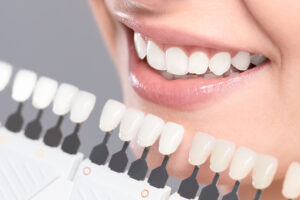Basics of Implantology
Implantology is a major focus of our dental practice in Frankfurt Nordend Zahnarzt Frankfurt. In the following we would like to explain in more detail which procedure is used in…
Implantology is a major focus of our dental practice in Frankfurt Nordend Zahnarzt Frankfurt. In the following we would like to explain in more detail which procedure is used in…
„Das Leben ist kurz, also lächle solange du noch Zähne hast!“ Damit Ihnen dieses Szenario eines Lückengebisses oder gar zahnlosen Kiefers erspart bleibt, möchten wir, die Zahnarztpraxis Dr. Hakimi und…
"Smiling is the most elegant way to show your teeth to your opponents!" With our aligner 3D scanner therapy, nothing stands in the way of your most beautiful and straight…
Zahnimplantaten ist ein großer Schwerpunkt unserer Zahnarztpraxis in Frankfurt Nordend Im Folgenden möchten wir etwas genauer erläutern welches Vorgehen bei uns zum Einsatz kommt, damit Sie sich ein besseres Bild…
Implantology is a major focus of our dental practice in Frankfurt Nordend Zahnarzt Frankfurt. In the following we would like to explain in more detail which procedure is used in…
When you smile, you show your joy, confidence, and beauty. Your smile genuinely comes from the heart, but the confidence you exhibit in a healthy smile comes from good dental…
A dental consultations is as important and vital as your doctor's consultation. Your oral health is an indication of your overall health. Your dental hygiene is essential to maintain your…
Volkskrankheit Parodontose: erst mit Plaque, dann mit Irrtümern behaftet Die Parodontitis gehört zu den häufigsten Zahnerkrankungen und ist eine von jenen, deren Ursachen in mangelnder Zahnhygiene und -pflege liegen. Mediziner…
Als Brånemark im Jahre 1969 seine Studien zur Osseointegration veröffentlichte und somit die Grundlage für die heute angewendeten Implantate lieferte, konnte niemand damit rechnen, welchen Stellenwert die zahnärztliche Implantologie im…
Professionelle Zahnreinigung beinhaltet die Entfernung von Plaque und Zahnstein durch Ihre Zahnarzt Frankfurt. Dies wird ein- bis mehrmals jährlich empfohlen, auch wenn Sie eine regelmäßige Zahnhygiene betreiben. Der Grund…

[vc_row][vc_column][vc_column_text]Bleaching gives you white teeth and makes your smile shine. Incisor misalignments as well as unsightly spaces and tooth surfaces can be made more attractive with veneers. This all can…
Das Lächeln jedes Kindes, von Kleinkindern bis zu Teenagern, ist sehr wertvoll. Für die Eltern kann es nichts Schöneres und Befriedigenderes geben, ihr Kind glücklich, gesund und lächelnd zu sehen.…
Unser Notfall Zahnarzt Frankfurt ist für Sie täglich während unserer Öffnungszeiten erreichbar. Sie können uns im Oeder Weg 52-54 besuchen. Hierfür klicken Sie einfach auf die Karte [hier klicken Karte]. Sie…
Sie suchen eine Zahnarztpraxis in Frankfurt, in der Sie von Spezialisten mit höchstem Qualitätsanspruch in der Implantologie beraten und betreut werden? Wir heißen Sie herzlich willkommen in unserer Praxis. In…
Menschen mit Zahnschmerzen, Kieferschmerzen und anderen traumatischen Erlebnissen aufgrund von geschädigten Zähnen, können sich gerne an uns wenden. Unsere Zahnärzte bieten die Diagnose und Behandlung aller Zahnerkrankungen einschließlich der Implantologie.…